Physical Address
304 North Cardinal St.
Dorchester Center, MA 02124
The interrelationships between the uterus and the surrounding muscles, nerves, vessels, and organs determine both the pathophysiology of uterine function and dysfunction in addition to the therapeutic modalities available when pathologies exist. The viscera contained within the female pelvis minor include the pelvic colon, urinary bladder and urethra, uterus, uterine tubes, ovaries, and vagina. As with the pictures illustrating the structures of the male pelvis, the topography of the female pelvis is demonstrated in two sections.
The pelvic colon is surrounded by peritoneum and attached by its mesocolon to the medial border of the left psoas muscle and the sacrum, down to the third sacral vertebra. Its greater part lies in a horizontal plane, though it may occupy many positions, including the superior surface and posterior aspect of the uterus. The rectum extends from the third sacral vertebra to just beyond the tip of the coccyx. It is covered by peritoneum in front and at the sides in its upper third and in front only in its middle third; its lower third is devoid of peritoneum. During pregnancy, this close apposition between the uterus and rectosigmoid often contributes to or worsens the impact of constipation.
The ureter enters the true pelvis by crossing in front of the bifurcation of the common iliac artery and descends to the pelvic floor on the lateral pelvic wall. At the level of the ischial spine, it runs forward and medially, beneath the broad ligament, between the uterine and vaginal arteries to the lateral vaginal fornix. At this point it is approximately 2 cm lateral to the cervix, a point of potential injury during hysterectomy. The ureter then ascends in front of the vagina for a short distance to reach the base of the bladder, where it opens into the lateral angle of the trigone by piercing the bladder wall obliquely.
The urinary bladder lies behind the symphysis, in front of the uterus and the vagina. Its base is in direct contact with the anterior vaginal wall. The neck of the bladder lies on the superior surface of the urogenital diaphragm and is continuous with the urethra. The superior surface is covered by peritoneum and is in contact with the body and fundus of the anteflexed uterus. It is this reflection that must be mobilized during the course of cesarean delivery. The space of Retzius lies between the pubis and the bladder and is filled with extraperitoneal adipose tissue.
The topographic relationships of the uterus are observed in the cross sections as depicted on this page. The superior surface of the uterus is convex and generally directed forward. The anterior surface is flat and looks downward and forward, resting on the bladder. Its peritoneal covering is reflected at the level of the isthmus to the upper aspect of the bladder, creating the vesicouterine pouch. The posterior surface of the uterus is convex and lies in relation to the pelvic colon and rectum. The peritoneum of the posterior wall covers the body and upper cervix and then extends over the posterior fornix of the vagina to the rectum, to form the rectouterine pouch or cul-de-sac of Douglas. Laterally, the visceral peritoneum becomes the anterior and posterior leaves of the broad ligament.
The cervix is directed downward and backward to rest against the posterior vaginal wall. Only the upper half of its posterior surface is covered by peritoneum. The external os of the cervix lies at about the level of the upper border of the symphysis pubis in the plane of the ischial spine.
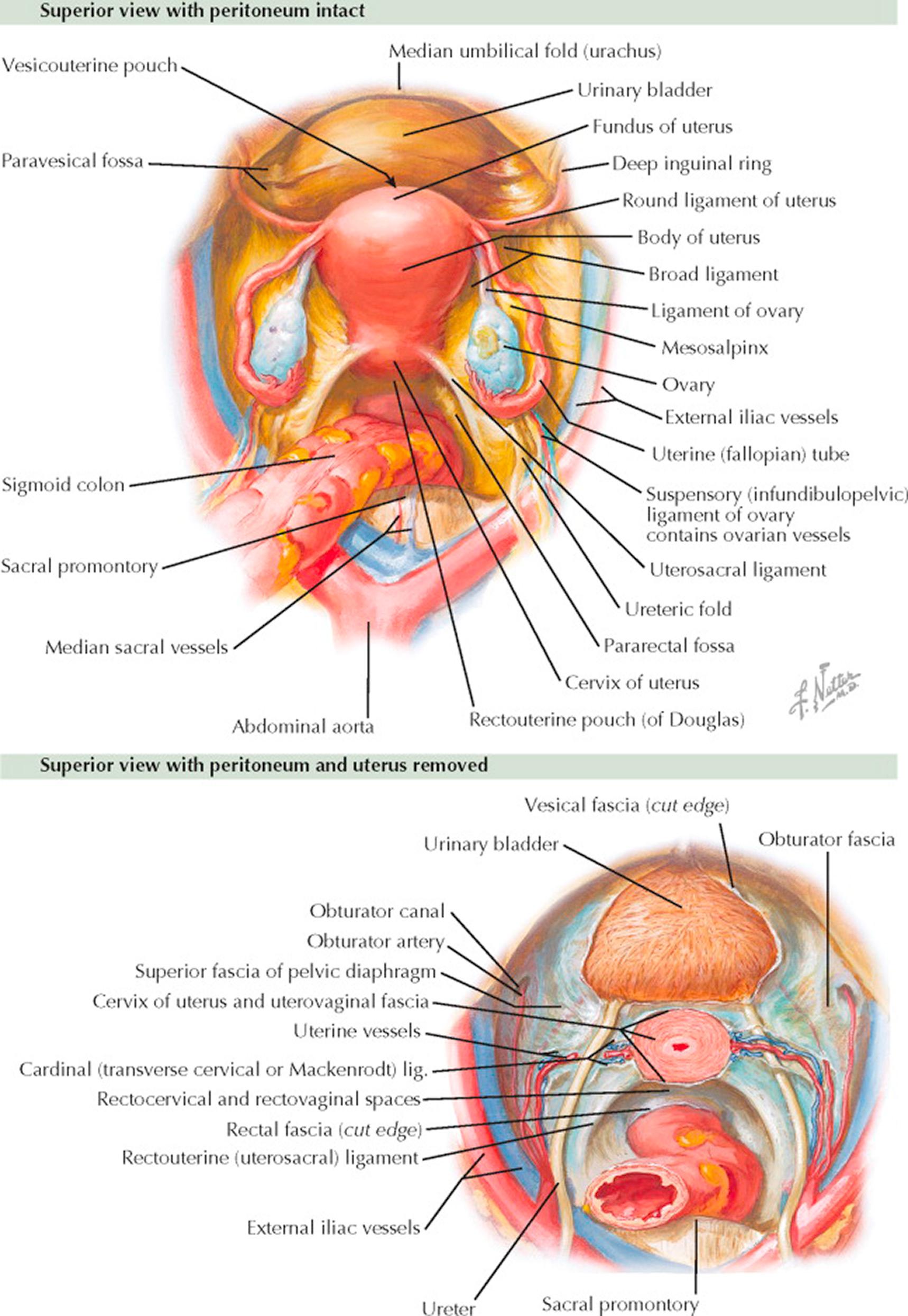
Although the muscular hammock of the levator plate provides the caudal (inferior) floor for the pelvic viscera, the organs of the pelvis have their own mechanisms of support. When either or both of these two support systems fail, this failure can result in clinical dysfunction. Understanding these supports can not only explain pathologies when present but also the therapeutic strategies that may be applied in their correction.
The term endopelvic fascia (actually a pseudofascia) refers to the reflections of the superior fascia of the pelvic diaphragm upon the pelvic viscera. At the points where these hollow organs pierce the pelvic floor, tubular fibrous investments are carried upward from the superior fascia as tightly fitting collars, which blend with and may even become inseparable from their outer muscle coat. Thus, three tubes of fascia are present, encasing, respectively, the urethra and bladder, the vagina, and the lower uterus and the rectum. These fascial envelopes, with interwoven muscle fibers, are utilized in the repair of cystoceles and rectoceles anteriorly and posteriorly. It is also within this fibrous tube investing the lower uterine segment that the so-called intrafascial hysterectomy is performed in an effort to protect the support of the remaining vaginal cuff. The vesical, uterine, and rectal layers of endopelvic fascia are continuous with the superior fascia of the pelvic diaphragm, the obturator fascia, the iliac fascia, and the transversalis fascia.
Uterine support is maintained directly and indirectly by a number of peritoneal, ligamentous, fibrous, and fibromuscular structures. Of these, the most important are the cardinal ligaments and the pelvic diaphragm with its endopelvic fascial extensions. The vesicouterine peritoneal reflection is sometimes referred to as the anterior ligament of the uterus, and the rectouterine peritoneal reflection as the posterior ligament. These are not true ligaments and they provide only limited additional support. The round ligaments are flattened bands of fibromuscular tissue invested with visceral peritoneum that extend from the angles of the uterus downward, laterally, and forward, through the inguinal canal to terminate in the labia majora.
The sacrouterine (uterosacral) ligaments are true ligaments of musculofascial consistency that run from the upper part of the cervix to the sides of the sacrum. At the uterine end, they merge with the adjacent posterior aspect of the cardinal ligaments and the endopelvic fascial tube. The broad ligaments consist of winglike double folds of peritoneum reflected from the lateral walls of the uterus to the lateral pelvic walls. Their superior margins encase the uterine tube and round ligaments. They then continue as the infundibulopelvic ligaments as they progress laterally and superiorly. Inferiorly, the ensheathed uterine vessels and cardinal ligaments may be felt. Within the two peritoneal layers are to be found loose areolar tissue and fat, the fallopian tube, the round ligament, the ovarian ligament, the parametrium, the epoöphoron, paroöphoron and Gartner duct, the uterine and ovarian vessels, lymphatics, and nerves.
The cardinal or transverse cervical ligaments (of Mackenrodt) are composed of condensed fibrous tissue and some smooth muscle fibers. They extend from the lateral aspect of the uterine isthmus in tentlike fashion toward the pelvic wall, to become inserted, fan-shaped, into the obturator and superior fasciae of the pelvic diaphragm. This triangular septum of heavy fibrous tissue includes the thick connective tissue sheath, which invests the uterine vessels. Mesially and inferiorly, the cardinal ligaments merge with the uterovaginal and vesical endopelvic fascial envelopes. Posteriorly, they are integrated with the uterosacral ligaments.
The vesical and rectal endopelvic fasciae maintain bladder and rectum support, respectively.
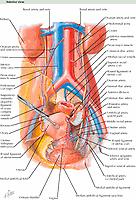
With the exception of the ovarian, superior hemorrhoidal, and middle sacral arteries, the hypogastric divisions of the common iliac arteries supply the pelvic viscera.
The ovarian arteries arise from the aorta just below the origin of the renal vessels, at the same level at which the internal spermatic artery departs from the aorta in the male. The ovarian arteries course obliquely downward and laterally over the psoas major muscle and the ureter. They enter the true pelvis by crossing the common iliac artery just before its bifurcation. The ovarian artery enters the broad ligament at the junction of its superior and lateral borders. Continuing beneath the fallopian tube, it enters the mesovarium to supply the ovary. In addition to broad anastomoses with the ovarian rami of the uterine arteries, branches extend to the ampullar and isthmic portions of the tube, the ureter, and the round ligament.
The middle sacral artery is embryologically the continuation of the aorta, which, owing to the strong development of the two common iliac arteries, has become a very thin vessel. It passes in the midline downward over the anterior surface of the fourth and fifth lumbar vertebrae, the sacrum and the coccyx, and terminates in the glomus coccygeum, after giving off lumbar, lateral, sacral, and rectal branches, which anastomose with branches of the iliolumbar artery and supply muscular and bony structures of the posterior pelvic wall.
The common iliac arteries are divisions of the abdominal aorta, which bifurcates at the left side of the body of the fourth lumbar vertebra. An important clinical landmark is that the right common iliac artery crosses anterior to the left common iliac vein, which can unilaterally compress the iliac venous system, resulting in relative venous stasis. This venous stasis increases the risk of venous thrombosis in the left iliac venous system, known as the May-Thurner syndrome. The common iliac arteries diverge and divide into the external iliac and hypogastric (internal iliac) arteries. The ovarian vessels, the ureter, and the sympathetic nerve fibers descending to the superior hypogastric plexus cross the right common iliac artery. The left common iliac artery, in addition, is covered by the sigmoid colon and mesocolon and by the termination of the inferior mesenteric artery.
The external iliac artery is the larger of the two subdivisions of the common iliac. It extends downward along the superior border of the true pelvis to the lower margin of the inguinal ligament. It lies upon the medial border of the psoas major muscle. Midway between the symphysis pubis and the anterior superior iliac spine, it enters the thigh as the femoral artery.
The uterine artery arises from the anterior division of the hypogastric artery close to, or in common with, the middle hemorrhoidal or vaginal artery. It courses slightly forward and medialward on the superior fascia of the levator ani muscle to the lower margin of the broad ligament. The uterine artery, after entering the broad ligament, is surrounded in the parametrium by the uterine veins and a condensed sheath of connective tissue. It arches over the ureter about 2 cm lateral to the cervix. This topographic relationship is of extreme surgical importance. At the level of the isthmus, it gives off a descending cervical branch, which surrounds the cervix and anastomoses with branches of the vaginal artery. The main uterine vessels follow a tortuous course upward along the lateral margin of the uterus, giving off spiral branches to the anterior and posterior surfaces of the uterus. The uterine artery terminates in a tubal branch within the mesosalpinx, and an ovarian ramus, which anastomoses with the ovarian artery in the mesovarium.

The lymph nodes of the pelvis receive lymphatic drainage from the pelvic organs and the groin. They tend to follow the course of the larger vessels and are named accordingly. The pelvic lymph nodes are shown in the upper picture as they may be visualized in the most frequent surgical approaches, namely, the intraperitoneal and extraperitoneal radical dissection for neoplastic lymph node involvement. More and more, this view is not what is seen surgically because of a growing use of laparoscopic or robotically assisted laparoscopic lymph node dissection. These allow magnification and a dexterity of dissection that makes up for the more restricted overall field of view.
Located in the pelvis, the external iliac nodes are situated about the external iliac vessels superiorly and inferiorly. There are two distinct groups: one situated lateral to the vessels and the other posterior to the psoas muscle. The distal portion of the posterior group is enclosed in the femoral sheath. These nodes receive afferent vessels from the femoral nodes, the external genitalia, the deeper aspects of the abdominal wall, the uterus, and the hypogastric nodes. Some efferent lymphatics extend to the hypogastric nodes, but for the most part they pass upward to the common iliac and periaortic nodes. The majority of lymphatic channels to this group of nodes originates from the vulva, but there are also channels from the cervix and lower portion of the uterus. The external iliac nodes receive secondary drainage from the femoral and internal iliac nodes.
The hypogastric nodes (internal iliac group) lie in close relation to the hypogastric veins. The internal iliac nodes are found in an anatomic triangle whose sides are composed of the external iliac artery, the hypogastric artery, and the pelvic side wall. Included in this clinically important area are nodes with special designation, including the nodes of the femoral ring, the obturator nodes, and the nodes adjacent to the external iliac vessels. This rich collection of nodes receives channels from every internal pelvic organ and the vulva, including the clitoris and urethra.
The number of nodes and their locale are variable; rather constant nodes can be found at the junction of the hypogastric and the external iliac veins, in the obturator foramen close to the obturator vessels and nerve (the obturator node) and at the base of the broad ligament near the cervix, where the ureter runs beneath the uterine artery (ureteral node). The middle sacral nodes (node of the promontory) lie alongside the middle sacral vessels. Lateral sacral nodes may be found in the hollow of the sacrum in relation to the lateral sacral vessels. The hypogastric nodes receive afferents from the external iliac nodes, the uterus, vagina, bladder, lower rectum, and some vessels from the tubes and ovaries. Efferent lymphatics pass to the common iliac and periaortic nodes.
The common iliac nodes lie upon the mesial and lateral aspects of the common iliac vessels and just below the bifurcation of the aorta. Most of these nodes are found lateral to the vessels. Besides those afferents just mentioned, they also receive primary afferents from the viscera, including the cervix and the upper portion of the vagina. Secondary lymphatic drainage from the internal iliac, external iliac, superior gluteal, and inferior gluteal nodes flows to the common iliac nodes. Efferent lymphatics extend upward to the periaortic nodes.
The periaortic chain of nodes lies in front of and lateral to the aorta. These drain into the lumbar trunks, which terminate in the cisterna chyli. They receive afferents from the iliac nodes, the abdomen and pelvic organs, the tubes and ovaries, and the deeper layers of the parietes.
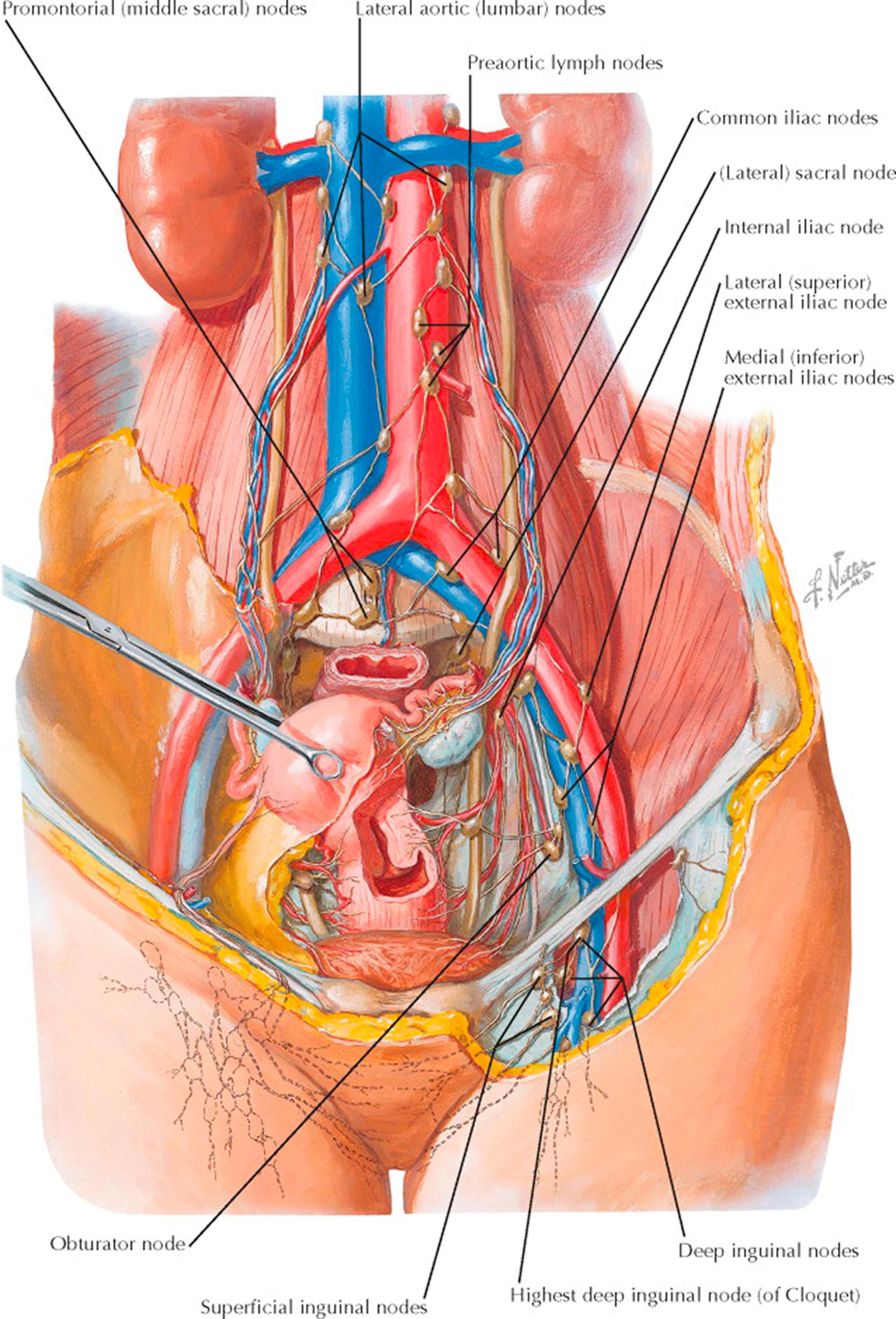
The lymphatics of the uterus are contained within three main networks or plexuses—one at the base of the endometrium, another in the myometrium, and a third subperitoneally. No lymphatics, surprisingly, have been detected in the superficial parts of the endometrium. The principal collecting trunks pass outward at the isthmus along the course of the uterine vessels. Drainage from the uterine body and from the cervix is similar, except that, in the region of the fundus, lymphatics are more likely to pass directly along with the ovarian lymphatics to the periaortic nodes. Occasionally, also, lymphatics may extend along the inguinal ligament to the femoral nodes. The number of lymph nodes in the group of parauterine nodes is small; most frequently there is a single node immediately lateral to each side of the cervix and adjacent to the pelvic course of the ureter. Although anatomists frequently do not comment about the parauterine nodes, the group receives special attention in radical surgical operations to treat uterine or cervical malignancy. Primary drainage to this node originates in the vagina, cervix, and uterus. Secondary drainage from this node is to the internal iliac nodes on the same side of the pelvis.
In lesions of the cervix, lymphatic drainage to the ureteral nodes, the lateral sacral nodes, and the nodes of the promontory may occur early. This drainage path allows for the evaluation of so-called sentinel nodes in cervical cancer patients. The premise of this is that if the sentinel node is free of disease, the chance that the remaining regional lymph nodes are also disease free is more than 95%. This technique identifies the most likely first site of nodal metastases in a regional lymph node basin. Sentinel lymph node biopsy can be performed laparoscopically or as part of an open procedure. Although pelvic lymphadenectomy remains the standard for patients with cervical cancer, the use of sentinel lymph node biopsy for these patients is increasing.
From the uterus as a whole, afferent lymphatics may extend to the ureteral, obturator, hypogastric, external and common iliac, periaortic, lateral and middle sacral and the femoral nodes. Occasionally, also, intercalated nodes may be involved between uterus and bladder or rectum. Although the afferent collecting lymphatics in the broad ligament are equipped with valves, the lymphatics of the uterus proper have none.
The ovarian lymphatics pass through the infundibulopelvic ligament along with the ovarian vessels to the lateral periaortic lymph nodes. On the left side, primary nodes may be situated between the left ovarian and left renal veins. On the right side, they may be found between the right renal vein and the inferior vena cava. Shorter lymphatic pathways may also lead to the hypogastric nodes.
The tubal lymphatic drainage is similar to that of the ovaries. In addition, afferents drain to the common iliac nodes and those of the sacral promontory. The sacral nodes are found over the middle of the sacrum in a space bounded laterally by the sacral foramina. These nodes receive lymphatic drainage from both the cervix and the vagina. Secondary drainage from these nodes runs in a cephalad direction to the subaortic nodes.
The lymphatics of the vagina share the lymphatic pathways of the cervix to the ureteral, hypogastric, obturator, external iliac, lateral sacral, and promontory nodes. Intercalated nodes between the vagina and bladder or vagina and rectum may also be present. The lowermost portion of the vagina, like the vulva, may drain to the femoral nodes.

The pelvic organs are predominantly supplied by the autonomic nervous system. The sympathetic portion of the autonomic nervous system originates in the thoracic and lumbar portions of the spinal cord, and sympathetic ganglia are located adjacent to the central nervous system. In contrast, the parasympathetic portion originates in cranial nerves and the middle three sacral segments of the cord, and the ganglia are located near the visceral organs. Although the fibers of both subdivisions of the autonomic nervous system frequently are intermingled in the same peripheral nerves, their physiologic actions are usually directly antagonistic: sympathetic fibers in the female pelvis produce smooth muscle contraction, including the smooth muscle of the vascular system (vasoconstriction), whereas parasympathetic fibers cause the opposite effect on muscles and vasodilation.
Although autonomic nerve fibers enter the pelvis by several routes, the majority are contained in the superior hypogastric plexus, a caudal extension of the aortic and inferior mesenteric plexuses. From the inferior aspect of the celiac plexus at the level of the superior mesenteric artery, two or three intermesenteric nerves, connected by communicating branches, descend over the anterolateral surface of the aorta, receiving fibers from the inferior mesenteric and lumbar sympathetic ganglia. At the bifurcation of the aorta, they join to form the superior hypogastric plexus or presacral nerve. The superior hypogastric plexus is found in the retroperitoneal connective tissue. It extends from the fourth lumbar vertebra to the hollow over the sacrum. In its lower portion, the plexus divides to form the two hypogastric nerves that run laterally and inferiorly. These pass downward and laterally near the sacral end of each uterosacral ligament and then forward over the lateral aspect of the rectal ampulla and upper vagina. In this vicinity they are known as the pelvic plexuses. These nerves spread out to form the inferior hypogastric plexus in the area just below the bifurcation of the common iliac arteries. A middle hypogastric plexus, overlying and just below the sacral promontory, may sometimes be present.
Each pelvic plexus is composed of interlacing nerve fibers and numerous minute ganglia, spread over an area of 2 or 3 cm 2 . They receive branches from the sacral ganglia of the sympathetic trunk and parasympathetic fibers from the second, third, and fourth sacral spinal nerves (nervi erigentes or pelvic nerves). The pelvic plexus of nerves is subdivided into secondary plexuses, which follow the course of the visceral branches of the hypogastric vessels. These include the rectal plexus (to rectum), the uterovaginal plexus (to inner aspect of fallopian tubes, uterus, vagina, and erectile tissue of vestibular bulb), and the vesical plexus (to bladder).
The ovarian plexuses are composed of a meshwork of nerve fibers, which arise from the aortic and renal plexuses and accompany the ovarian vessels to supply the ovaries, the outer aspect of the fallopian tubes, and the broad ligaments.
The anatomic relations of the presacral nerve, or superior hypogastric plexus, are of importance because its resection is sometimes performed for the relief of intractable pelvic pain. Beneath the peritoneum at the level of the bifurcation of the aorta, the superior hypogastric plexus will be found embedded in loose areolar tissue, overlying the middle sacral vessels and the bodies of the fourth and fifth lumbar vertebrae. Usually, a broad, flattened plexus, consisting of two or three incompletely fused trunks, is found. In 20% to 24% of cases, a single nerve is present. Fine nerve strands pass from the lumbar sympathetic ganglia beneath the common iliac vessels to the presacral nerve. The right ureter is visualized as it courses over the iliac vessels at the brim of the pelvis.
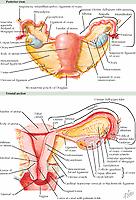
The uterus is a pear-shaped, thick-walled, hollow, muscular organ situated between the bladder and rectum. The fundus is the dome-shaped portion above the level of entrance of the fallopian tubes. The body, or corpus, lies below this and is separated from the cervix by a slight constriction, termed the isthmus. The cavity of the uterine body is a flattened potential space, triangular in shape. The uterine tubes open into its basal angles. Its apex is continuous with the cervical canal at the internal os. The uterine wall is composed of an outer serosal layer (peritoneum); a firm, thick, intermediate coat of smooth muscle (myometrium); and an inner mucosal lining (endometrium).
The cervix is cylindric, slightly expanded in its middle, and about 2.5 cm in length. Its canal is spindle-shaped and opens into the vagina through the external os. On the anterior and posterior walls, the endocervical mucosa is raised in a series of palmate folds. The cervical wall is more fibrous than that of the corpus. The oblique line of attachment of the vagina to the cervix divides the latter into supra- and infravaginal segments. About one-third of the anterior surface and one-half of the posterior surface of the cervix constitute the vaginal portion.
The peritoneum covers the fundus and corpus uteri on both its anterior and posterior aspects, reflecting at the cervicouterine junction to cover the vesicouterine excavation in front and the rectouterine excavation (cul-de-sac, pouch of Douglas) in back, from where it spreads over the bladder and rectum, respectively. At its lowest part, the peritoneum covers the cardinal ligament, which stretches laterally across the pelvic floor to the lateral pelvic walls.
The peritoneal layers that sheathe the fundus and uterine body unite on both sides of the uterus to form the broad ligament, which separates the vesicouterine and rectouterine pouches. The upper borders of the broad ligaments are folds of the peritoneum coming into existence when the anterior sheath turns to become the posterior sheath. These folds enclose the fallopian tubes. The broad ligaments expand downward from the lower edges of the tubes, assuming the function of a mesentery to the tubes, the mesosalpinx, in which the vessels to and from the tube take their course. In the mesosalpinx are also found the vestigial remnants of the mesonephric ducts.
The extreme lateral parts of the tube—the fimbriated infundibulum and ampulla—are not enclosed by the broad ligament and open into the peritoneal cavity. However, the latter forms in this region a band, the infundibulopelvic ligament, which attaches the posterior surface of this end of the tube to the lateral wall of the pelvis. Another peritoneal fold, the suspensory ligament of the ovary, crosses the iliac vessels and runs medially to the free ends of the tubes. It contains the ovarian vessels and provides an attachment of the lateral pole of the ovary. This fold is not to be confused with the ligament of the ovary, a cord within the broad ligament running from the lateral angle of the uterus just below the uterine end of the tube downward to the lower or uterine margin of the ovary. The ovary is not wrapped by the broad ligament. Only its lateral surface lies upon the parietal pelvic peritoneum, where the external iliac vessels, the obliterated umbilical artery, and the ureter form a shallow depression called the ovarian fossa. The anterior border of the ovary is attached to the posterior layer of the broad ligament by a short fold through which the blood vessels pass to reach the hilum of the ovary. For this reason, the fold has been named the mesovarium.

In response to the ebb and flow of estrogenic secretions, the uterus exhibits two patterns of growth and development—one a lifelong curve from infancy to senility, and the other a transient recurrent increment and recession due to the swings of ovarian activity in each menstrual cycle.
Up to the seventh month of fetal life, the uterus grows in proportion to the rest of somatic development. Thereafter, a disproportionate acceleration in size takes place; this is considered to be a specific response to the high level of estrogens present in the mother as she approaches term.
Within a few days after birth, the infant's uterus shrinks somewhat because of the abrupt withdrawal of maternal hormones, which may even, at times, be sufficient to result in some vaginal spotting or frank bleeding. Thereafter, the size of the uterus remains static until, as a prelude to the menarche, the ovaries start to produce hormones.
Uterine growth is one of the earliest signs of puberty and generally precedes the menarche by 1 or 2 years. In 60% of girls, the uterus reaches adult size by the 15th year. By this time, a difference in proportion of length of the cervix to that of the fundus becomes evident. In the newborn and prepuberal uterus, the ratio of cervical length to that of the corpus is approximately 1:1. However, in the adult this ratio becomes 1:2 or greater. Measuring the distance from the external to the internal cervical os using a uterine probe and then measuring the total length of the uterine canal may confirm the diagnosis of an infantile organ in the adult.
When mature, the uterus is about 8 to 10 cm long. The uterine width at the top measures 7 by 5 cm. It narrows to a diameter of 2 to 3 cm at the cervix.
Repeated pregnancies leave the uterus larger than in the nulliparous woman. After the menopause, and its associated loss of hormonal stimulation, shrinking and atrophy progress. The senile uterus, with its thinned-out myometrium, often retrogresses to the size of the preadolescent stage. The ratio of cervical length to overall size often regresses to that found before puberty.
Because the uterus is formed by fusion of the müllerian ducts, its muscular structure is rather complex. The external longitudinal and internal circular fibers in the tubes are confluent with those in the uterus. Indeed, although the deep, spiraling, circular fibers sweep around the uterus in both clockwise and counterclockwise directions, each set is motivated independently by contractions that originate in each of the tubes. It appears that peristaltic waves initiated in the tubal walls act as lateral pacemakers for uterine contractions, which sweep down the fundus to the cervix. During labor, an element of rhythmicity results from a wandering pacemaker system of independent foci of initiator signals and strong interconnections between the cells through cellular gap-junctions.
Smooth muscle bundles contained in the supportive ligaments interdigitate with the circular muscle system of the uterus. The importance of this complicated and interlaced system, embracing tubes, uterus, and ligaments, is realized during the menstrual cycle, where smooth muscle contractions are found to be a function of ovarian activity. They occur with greater force and frequency during the preovulatory peak of estrogen production. This coordination of muscular contractions in the three different structures may also serve to orient properly the ovary with the infundibulum of the tube at the time of ovulation. Any pathologic condition interfering with the coordination or strength of contractions from the tubes may be an important cause for uterine dysrhythmia, inertia, or dysmenorrhea.
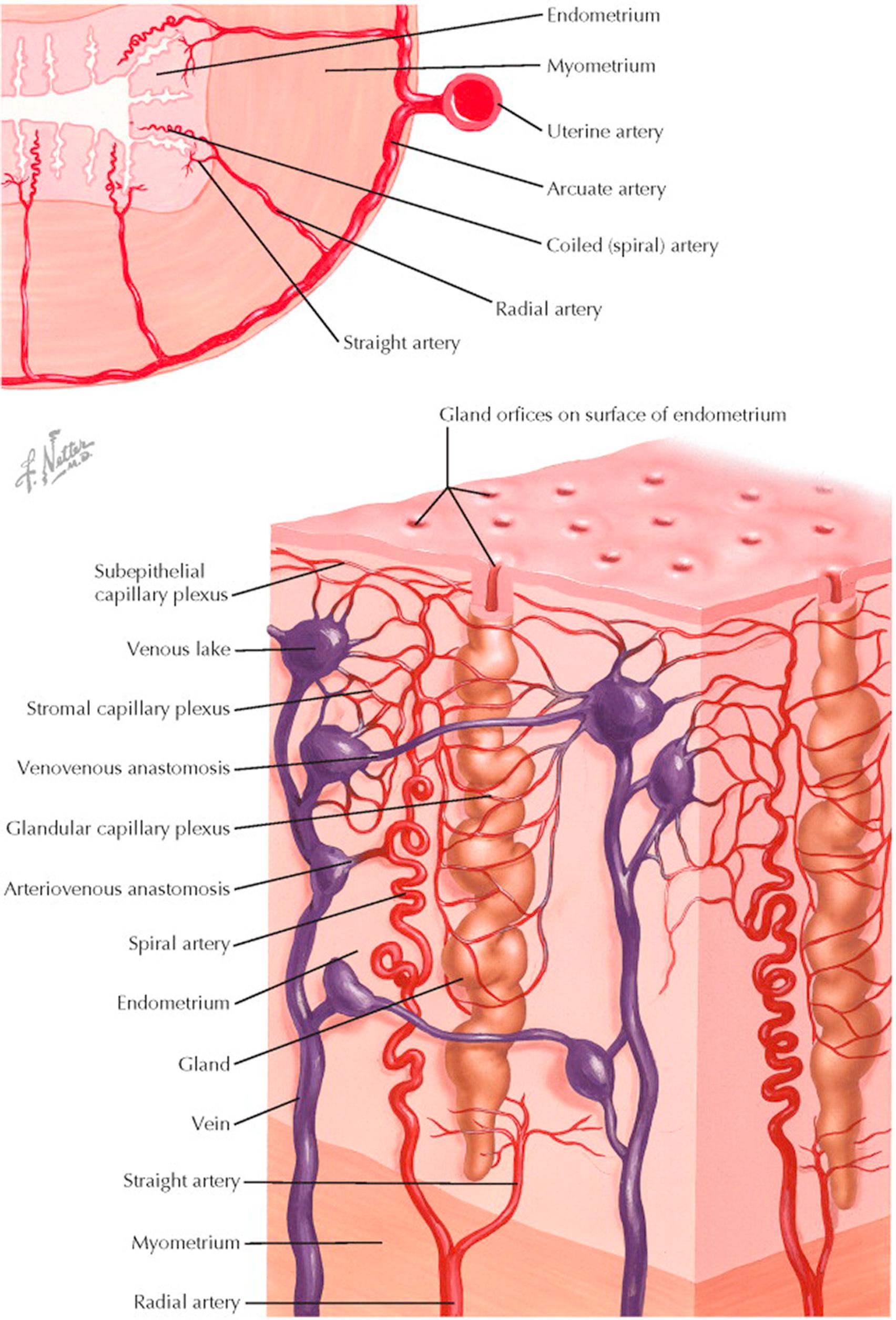
The arcuate arteries, which arise from the ascending and descending branches of the uterine arteries, circle the uterus just beneath the serosal surface. At intervals, they give off radial branches, which penetrate directly inward through the myometrium. Before entering the endometrium, the terminal branches of the radials divide into two distinct types of arteriole: straight and spiral arterioles.
The short, straight arterioles supply only the deeper third of the endometrium, ending in a more or less horizontal arborization of terminal twigs. These arterioles are not affected by cyclic hormonal changes; therefore, they maintain a continuous circulation, and the area that they supply (the deepest third of the endometrium) does not take part in the menstrual slough and necrosis. The basal layer, thus continuously nourished and left intact during menstruation, provides the gland with remnants from which regrowth of the entire epithelial thickness takes place during the intermenstrual period.
The spiral arterioles, on the other hand, reach to the surface of the endometrium and exhibit marked changes in response to hormonal changes through the normal cycle. Branches are given off to invest glands and to supply the stroma. Arteriovenous and venovenous anastomoses have been demonstrated that develop particularly during the secretory phase of the cycle. In the superficial layer, a diffuse arteriovenous capillary network terminates in venous lakes or sinusoids.
This complicated vascular pattern, unique to the endometrium, was once believed to be the mainspring of the processes that enact the rhythmic necrosis and hemorrhage called menstruation. The spiral arterioles undergo extraordinary lengthening during the first or proliferative phase of the cycle. The stromal elements proliferate also, but at a much slower rate. As a result of this difference in growing speed, the spiral arteries are thrown into complex kinks and coils. This coiling would be even more marked were it not for the simultaneous accumulation of interstitial edema fluid that starts with the first preovulatory peak of estrogen production. A second period of fluid retention is found at the height of steroid production by the corpus luteum later during the cycle. This “waterlogging” of the uterine mucosa may reflect the sodium- and chloride-retaining action of progesterone via renal mechanisms, which is an attribute held in common by all steroid hormones. As a result, the spiral arteries are somewhat stretched during the time of greatest luteal activity. In the absence of a fertilized, implanted ovum, the corpus luteum begins to degenerate a few days before the end of the cycle. This then is accompanied by the fall in blood levels of estrogen and progesterone and, consequently, by a resorption of the interstitial fluid. The endometrium shrinks, becomes denser, and forces the spiral arteries to kink and “buckle.” A slowed-down circulation, or even stasis, ensues.
From 4 to 24 hours preceding the onset of menstrual bleeding, an intense vasoconstriction and vascular clotting are seen. The vasoconstriction, together with the antecedent buckling, was thought to lead to severe ischemia and therewith necrosis of the superficial parts of the endometrium, progressing to the actual desquamation of menstruation. Based on human perfusion studies, we know that this is not the underlying mechanism of menstruation. Rather, the initiation of menstrual sloughing occurs as a result of direct enzymatic digestion of the superficial tissues, which is hormonally dependent in that progesterone withdrawal induces the expression of matrix metalloproteinases. At the end of this digestive process, coagulation takes over, a platelet plug first occurs with the more organized coagulation cascade following; then vasoconstriction of vessels occurs and reepithelialization of endometrial tissues takes place, generated from the undisturbed basal layers.
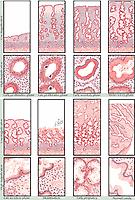
In the early proliferative phase of the menstrual cycle the endometrium is thin, and relatively homogeneous. The glands are simple and straight, leading directly from the base to the surface. Under high-power magnification, an occasional mitosis may be seen in the low columnar epithelial cells. A similar picture is found in prepubertal or postmenopausal endometrium, except that the endometrium is even thinner, consisting only of the basalis layer resting on the myometrium, and the glands are wholly inactive, the shrunken nuclei are pyknotic, and no mitoses appear to be present.
The late proliferative stage demonstrates marked growth in glands and stroma, with tortuosity of the glands and corkscrew convolutions. The stroma cells of the superficial layer may be separated by edema, and mitoses are frequently seen. The epithelium is higher and more columnar, and the nuclei are disorderly placed, both centrally and peripherally, at different levels in the cells.
Within 2 or 3 days after ovulation, the early signs of the secretory phase induced by progesterone are clearly visible. The endometrium shrinks slightly in thickness as the edema of the superficialis is lost. In the epithelial glands, the nuclei are now rounded and are arranged more or less in line in the middle of the cell. The cytoplasm of these cells is condensed toward the lumen by the accumulation of glycogen-rich secretions basally, but with hematoxylin and eosin staining this appears as a subnuclear empty space or vacuole. Mitoses are less common and disappear entirely by about day 20 of the cycle.
From day 21 through day 25, the endometrium is in active secretion; edema is now grossly apparent in the midlayer, so that the total thickness of the endometrium reaches a maximum. The glands take on a distinctive jagged or saw-toothed appearance. The round nuclei sink to a basal location, while secretions form vesicles at the luminal margin, which are disgorged into the gland lumen and leave the impression of a frayed and shaggy cellular edge. Arterioles exhibit a major increase in growth and tortuosity. Capillaries are prominent in the superficial layers, and contiguous stromal cells are first noted to become swollen and pale-staining.
Through the last 2 or 3 days (late secretory phase) of the cycle, regressive changes are found to coincide with a decrease and, finally, cessation of function of the corpus luteum. Endometrial intracellular edema is resorbed, causing shrinkage in total thickness of the endometrium. Superficially, the stroma cells accumulate cytoplasm in a dense layer called predecidua. The sectioned glands are widely dilated and filled with secretion and cellular debris. The glandular epithelium appears inactive, the cells are low columnar or cuboidal, and the nuclei are often pyknotic. With impending menstruation, an extensive diapedesis of red and white blood cells is seen in the stroma.
The process of menstruation first begins by a pooling of blood cells in intercellular spaces beneath the surface epithelium. Breaks in the surface occur, and pieces of stroma and broken glands are lifted off. Desquamation of the top layers down to the basalis takes place in 2 or 3 days. There are increased numbers of lymphocytes and polymorphonuclear leukocytes; the epithelial cells are characterized by pyknosis and fragmentation.
If conception has occurred, the secretory activity of the endometrium is maintained and increased by the corpus luteum of pregnancy. In a full-thickness specimen the thick, well-developed, true decidua extends well down into the midlayers, which are crowded with “saw-toothed” glands. The functioning cells are large, with basal, round, vesicular nuclei, filled with coarse granules except at the translucent luminal margin, where a distinct cell membrane balloons out into the gland lumen.

Become a Clinical Tree membership for Full access and enjoy Unlimited articles
If you are a member. Log in here